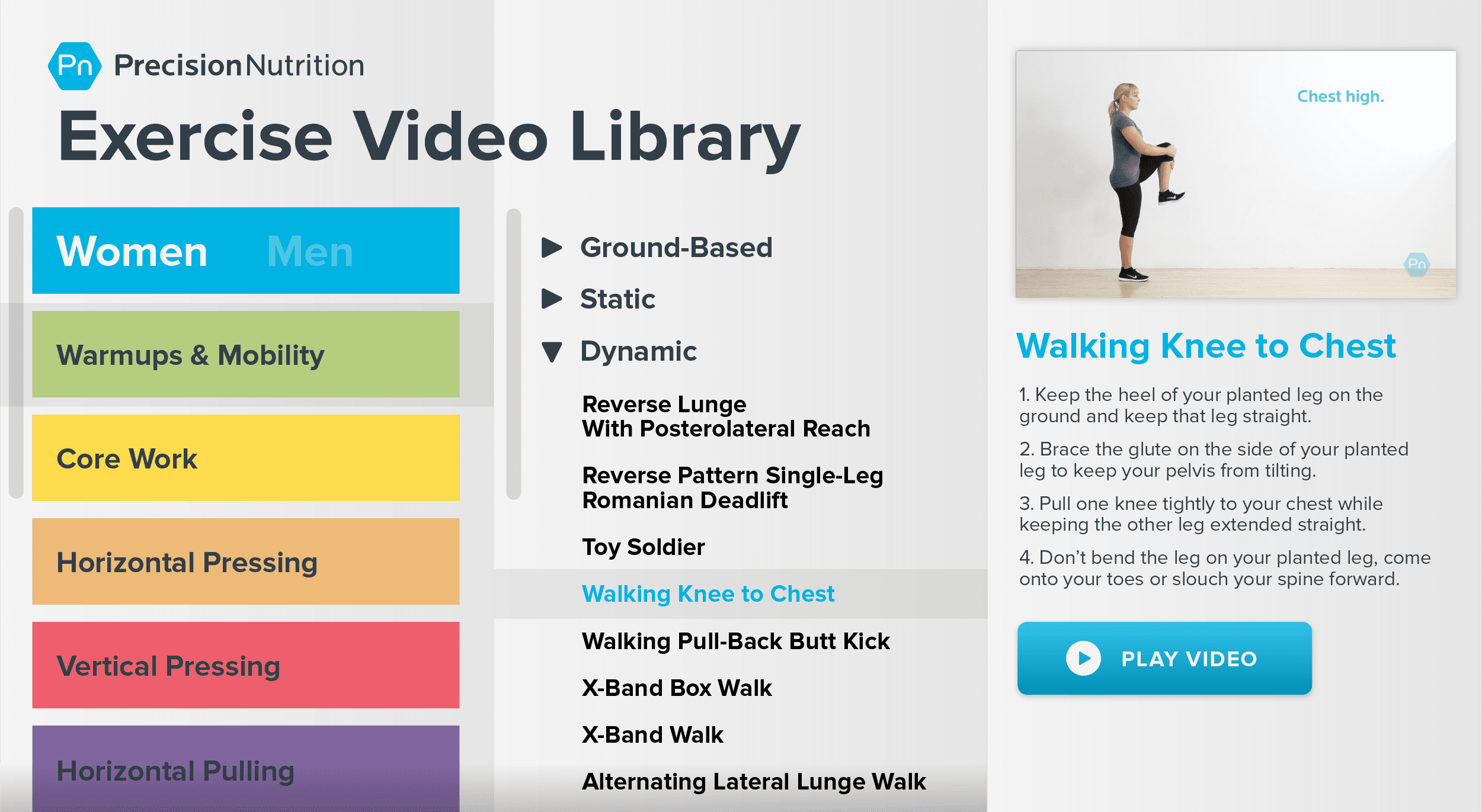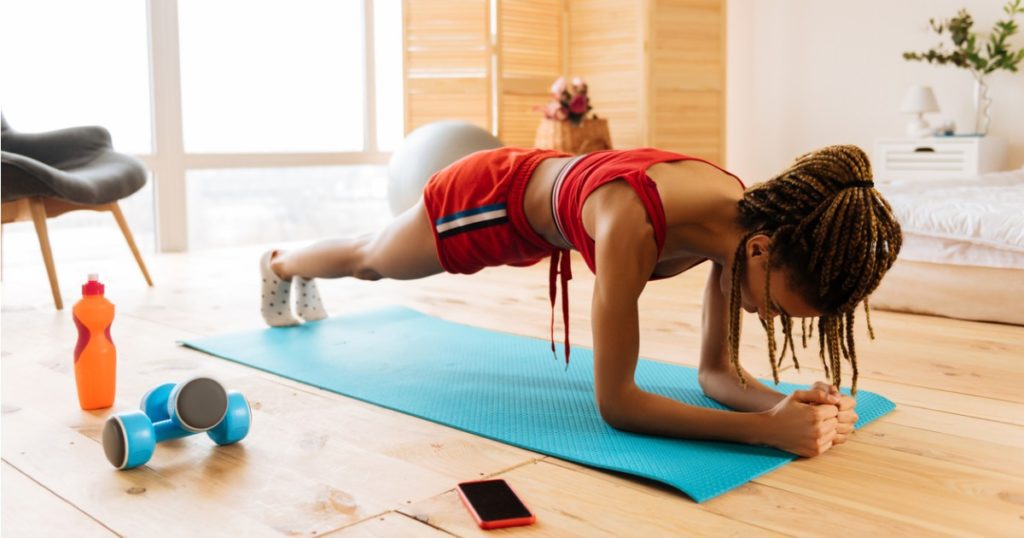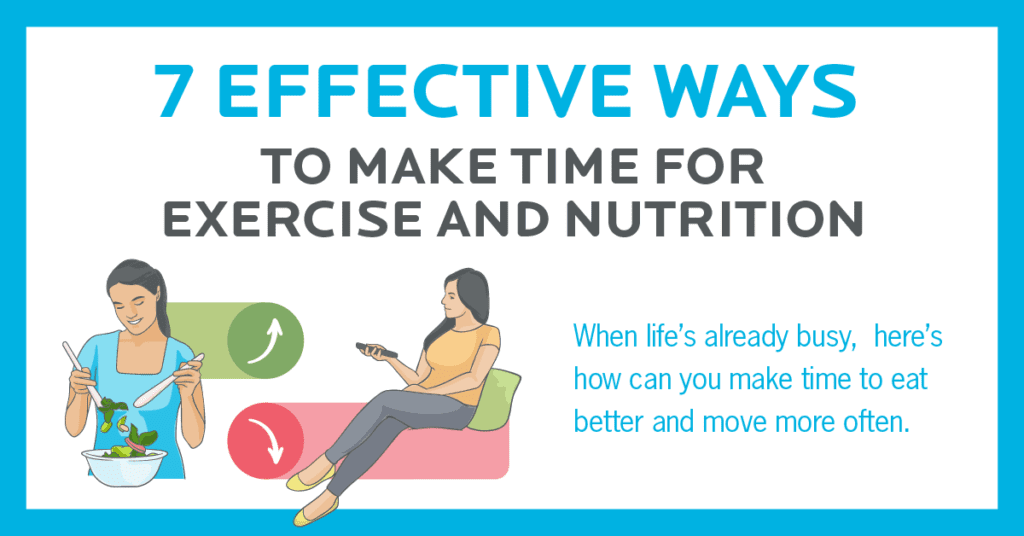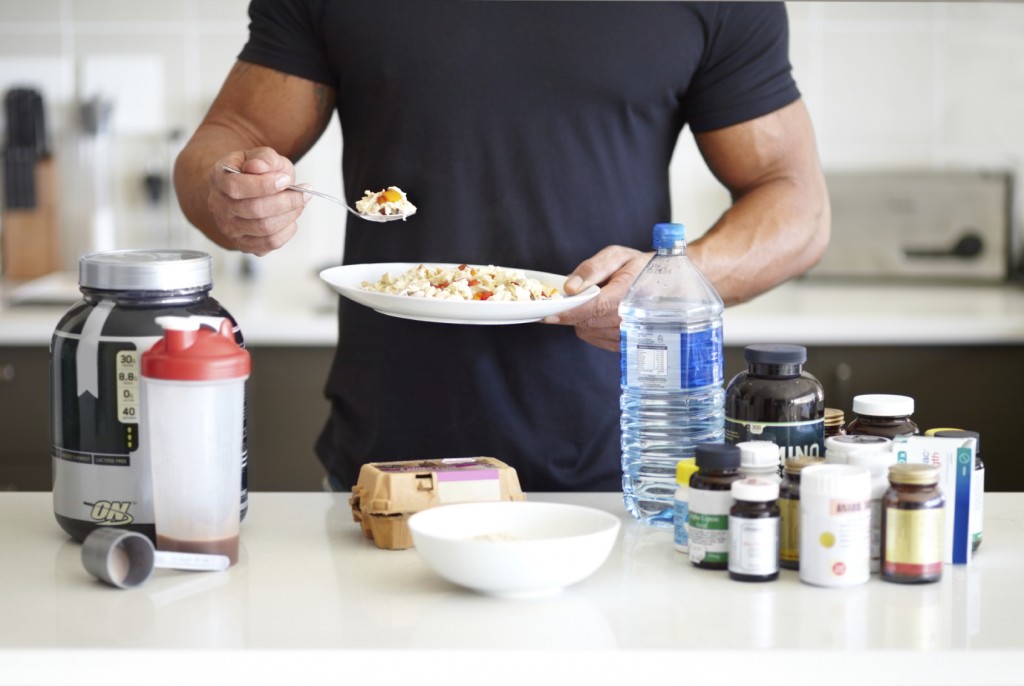This free exercise library from Precision Nutrition contains men’s and women’s versions of over 400 exercise videos.
It’s designed to be a resource for personal trainers and strength coaches who provide remote or online workout coaching. But it’s also freely available to anyone else who might benefit.
Every exercise video is filmed from multiple angles and provides performance pointers through audio narration and text overlays.
Plus, each video highlights common movement flaws to avoid during each stage of the exercise.
And it’s all organized into a searchable, filterable spreadsheet that allows you to copy and paste video links—and accompanying text exercise cues—right into your own material.
Personal trainers and strength coaches can use this video exercise library to:
- Include high-quality exercise demonstrations in your workout programs—without having to search the internet or create your own videos
- Send clients quick and reliable links to any exercise they may have questions about
- Provide clients with progressions, regressions, or modifications for popular exercises
And absolutely anyone can use this PN video library for expert instruction on how to perform hundreds of exercises safely.
As a bonus, we’ve also included a 14-day at-home workout program, to highlight how we use these movements in our Precision Nutrition programs. Feel free to download it for yourself, or share it with your friends, family members, or clients.
To get the most out of this video exercise library, keep reading. But if you’re ready to jump right to resources, you can click the links below.
How to use this video exercise library
The exercises in this video library are grouped in the downloadable spreadsheet in two different ways:
1. By movement pattern. You can search for any exercise by category. For example, if you’re looking for a regression or progression for a goblet squat, you can search through other squat pattern movements to find bodyweight, dumbbell, and barbell squat variations.
2. By name, alphabetically. We’ve also included an alphabetical list of every exercise in the video library. Plus, you can always do a simple keyword search within the spreadsheet to find the exercise you’re looking for.
Exercise principles for online coaching
You may already have an effective system for choosing the right exercises for your online clients. But if not, consider the advice that follows.
When selecting exercises for online or remote clients, it’s important to recognize this:
The exercises you regularly prescribe to in-person clients might not be appropriate for your online clients.
The reason: Compared to in-person coaching, your understanding of your clients’ movement skills—and your ability to enhance those skills through coaching—may vary significantly along a continuum.
For instance, you may have a range of online clients that include:
A. People you also work with in-person.
- You know how well they move and which movements they’re skilled in.
- You know how well they self-monitor their movement quality.
- You know how well they pace themselves.
B. People you’ve never met in person… but you’ve done a thorough online movement assessment and gotten to know them.
- You have a good grasp of their physical capabilities.
- They regularly send you movement videos for feedback.
- They pay close attention to their form while exercising.
C. People you don’t know well… and with whom you rarely correspond.
- You mostly send them workouts and nutrition material.
- You briefly check in with each other once or twice a month.
- They told you they’ve worked out off and on for a long time, but you’re not sure what that really means.
Depending on where clients are on this continuum, the following principles apply to some degree.
1. There won’t be an immediate feedback loop.
Exercise is a form of skill development.
Workouts metabolically and neurologically challenge motor patterns. This, in turn, elicits the training effects that develop athletic skills and produce results.
The development of any skill requires that you start with a mental model of what “good” is. For instance, ask yourself: What does a “good” squat or “good” pushup look like?
The goal is to then practice that mental model at the edge of your ability. Example: doing a squat for as many reps as you can with “good” form. (Once your form starts to break down, you’ve exceeded the edge of your ability.)
Over time, the metabolic, structural, and neural challenges of this activity drive the training effects we’re all familiar with:
- stronger muscles
- better coordination
- less body fat
Along the way, the quality of the movement pattern you practice—that is, how “good” your mental model is—affects the quality of those results. This also plays a big role in your long-term resiliency and injury risk.
So how do you improve and strengthen the quality of that movement pattern? By making and correcting small errors at the edge of your ability.
And the ability to do that? It depends on a feedback loop: a constant comparison of what you wanted to do, what you did, and how you can do it better the next time.
With in-person training, that feedback loop can come immediately and repeatedly from an expert coach.
For instance, after watching a client squat, you might say:
“Hey, on that last set of squats you started to lift your heels a bit and shift stress more into your knees and lower back. Next time, let’s mentally focus on keeping your heels rooted into the ground when you’re under fatigue. Or we can adjust the weight or reps to keep you in a quality pattern.”
In online coaching, though, that feedback loop can only come from the client. The obvious problem: It’s very difficult for people to self-monitor subtle shifts in movement quality while working out.
This means that small errors—and sometimes big ones—can continue unchecked for a long time. That slows down skill acquisition, and thus, progress. Worse, it can lead to movement dysfunction and frustrating injuries.
This brings us to point #2.
2. It’s important to rely on “high-fidelity” exercises.
Clearly, lack of immediate feedback is a challenge for online coaching.
But there’s a smart way to account for this: Adjust your exercise selection to favor “high-fidelity” movements.
These are exercises that are likely to be executed correctly without feedback and while under fatigue.
Think of two variables when choosing an exercise:
- The desired movement pattern (for example, a squat pattern)
- The loading necessary to get the desired training effect (for this specific client, at this particular spot in their workout, and at this point in their overall training program)
From here, choose the exercise with the highest likelihood of being executed safely and correctly… without feedback… while under stress and fatigue… and while still meeting conditions 1 and 2.
That’s a mouthful, we know. But the point: Considering each of these factors will help you choose the best exercises for each client.
And keep mind: A high-fidelity exercise for one client may not be a high-fidelity exercise for another client.
But some movements generally meet the standard for most people. Here’s a shortlist of high-fidelity exercises you might prioritize, and low-fidelity exercises you’ll want to program with greater discretion.
High-fidelity exercises
These exercises can usually be executed relatively reliably under fatigue with minimal feedback.
- Goblet squats
- Pushup variations
- Dumbbell reverse lunge variations
- Dumbbell rows
- Weighted carries
Low-fidelity exercises
Typically, you only want to use these exercises with 1) people who you know are highly skilled in performing them and self-monitor effectively, or 2) people that you’re working with in-person—so that you can provide immediate feedback as they train.
- Kettlebell swings, snatches, and cleans
- Olympic lifts
- Overhead squats
3. Adjusting protocols is more effective than varying exercises.
Let’s say you’ve chosen exercises your client can execute safely and correctly… without feedback… and while under stress and fatigue.
Great.
Now where do they go from here?
To improve, you want to add just enough novelty and challenge so that they’re breaking equilibrium and adapting to new stimuli. That is, make them work a little bit harder but without forcing them beyond the edge of their ability.
One way to add novelty is to vary the movement pattern by choosing a new exercise. For instance, moving from a goblet squat to a barbell squat.
This is the default approach for many people.
But remember, the goal isn’t to do the most variations of an exercise; the goal is to get better at the movement pattern itself, in order to accrue the adaptations that come from training progress.
The most effective and efficient way to do that is to adjust the training protocol, not the movement. Specifically, you might adjust:
- Sets
- Reps
- Rest periods
- Tempo
- Time durations
- Exercise combinations
In fact, by manipulating these variables, the nature and magnitude of the stress you can impose on the body with a single exercise is nearly limitless.
Think of all the effective training methods from the past few decades:
- 5/3/1 training
- French contrast training
- APRE (Auto-Regulatory Progressive Resistance)
- Litvinov sprints
- High-Intensity Continuous Training
- Escalating Density Training
- Breathing ladders
- Eustress volume training
- Anaerobic threshold complexes like “The Bear”
And countless others.
What do they all have in common? Most of them can be done with the same dozen exercises.
Here’s the thing: Progress isn’t really about the exercises you choose. It’s about how far you can take those exercises, through strategic programming.
How to Progress Exercises
Here at Precision Nutrition, we think of exercise progression in two ways:
- Intra-exercise progression: This is done by adjusting the way you perform a specific exercise, a.ka. the training protocol. For example, adding more sets and reps is a form of intra-exercise progression.
- Inter-exercise progression: This is when you vary the exercise itself, by using a dumbbell instead of a barbell, or by holding the weight in a different position (and so on).
Let’s take a look at both in more detail.
Intra-exercise progression
You can use intra-exercise progression by adjusting these variables:
- Quality: Improving exercise technique (this is often low-hanging fruit, and must always be considered).
- Volume: Increasing the numbers of sets and/or reps.
- Density: Increasing the number of reps performed in a specific time frame.
- Intensity: Increasing the weight used for an exercise.
- Complexity: Incorporating constraints on rate of perceived exertion, heart rate, or breathing (e.g. exclusively nose-breathing or using a fixed number of breaths during recovery intervals, such as during a breathing ladder).
If your protocol or program isn’t targeting an increase in one of these variables, you may be distracting yourself from the things that matter.
Inter-exercise progression
Only after you’ve explored the limits of progress you can make from intra-exercise progressions is it typically necessary and beneficial to start with inter-exercise progressions.
For instance, let’s say you’ve been working on squats.
You (or your client) started with a bodyweight squat and pretty quickly mastered that pattern, focusing initially on the quality of the movement.
You’re able to squat deeply with your heels firmly rooted to the ground, with good positioning and movement at your ankles, knees, hips, and spine.
To progress, you could add some density and volume by increasing your total reps and doing them in less time. But for the training adaptations you really want, you need some external load.
Based on that, it’s time to switch to a loaded version of the exercise, such as a goblet squat. This is an inter-exercise progression.
With this change, you can adjust the amount of weight you’re moving, which adds another intra-exercise variable you can progress over time.
Remember, you’re following the same fundamental checklist of criteria: Your heels are rooted, lumbar spine and pelvis are stable, hips are mobile, knees, and ankles track well. This stays with you for every progression.
Keep progressing with these principles.
Once you’ve switched the exercise you’re using, you can return to focusing on intra-exercise progression.
For example, you might work up to goblet squatting a 100-pound dumbbell for lots of reps (volume progression) in minimal time (density progression). Then you could do a high-volume, high-density workout while consciously controlling your breathing (complexity progression).
From here, you may want to add more weight again, but you’re limited by the amount you can hold in the goblet position (or you don’t have a heavier dumbbell). As a result, you need to choose a new exercise variation in this pattern. So you’re back to inter-exercise progression.
In this case, you might choose a barbell squat variation, like a front squat or back squat.
With these barbell lifts, your training intensity can be increased infinitely. Every workout can be made more challenging by putting more weight on the bar.
Most important: You’re ready for this because you’ve built a strong foundation to work from. That’s because you spent time building resilience and work capacity by pushing your limits on intra-exercise progressions.
This process—going from a bodyweight squat to a goblet squat to a barbell squat—could take several months.
Sometimes years.
Some people will never need to squat a barbell because they can accomplish what they need with a dumbbell.
But for those who do progress to barbell squats? The possibilities are endless. They can play with protocol variations that drive intra-exercise progress for the rest of their life.
Figuring out how to do all of this requires a lot of individualization.
You’ll need to decide which progressions to focus on, in what sequence, and how to monitor them, along with knowing what the specific goals are.
You need to ask questions like:
- What adaptations are you trying to induce?
- Are you working with an athlete with specific sport demands? Someone trying to build muscle? Lose fat? Gain freedom from back pain? Get their doctor to stop chastising them?
- What kind of equipment does your client have access to?
- What else is going on in their life?
- How much time do they have to train?
- What’s their movement background prior to working with you?
Every situation will require a different approach and a different layering of progressions and adaptations.
The progression described above—from bodyweight to goblet to barbell back squat—involves just three exercises, probably over a long period of time. Yet it allows for tremendous progress. (We’re not suggesting a program would only involve squatting exercises, by the way.)
Our point: The art of programming workouts lies much more in how you can build new levels of strength and capacity within a movement pattern than how many different exercises you can come up with.
Of course, you might wonder then…
Why are we providing a video library of 400 exercises?
A few reasons:
- Clients have different starting points, goals, abilities, and preferences, which calls for a full toolbox of movement options
- You may need to vary exercises in unique ways in order to increase the load (a feet-elevated pushup instead of a regular pushup)
- If a client gets injured or has a setback, you may need to modify or regress an exercise
- There may be a change in available training equipment, like if a client switches gyms or starts training only at home
But no matter how you use this exercise library, we hope you find it—and the accompanying information—to be a helpful resource.
Get instant access to Precision Nutrition’s 400+ video exercise library
There are a couple ways to start using the library:
- Use the Google Sheet to view and download the library in multiple formats.
- Make a copy of the Google sheet for your own use (you must have a Google account and be signed in for this option).
Download the 14-day at-home workout program
Click the PDF to download the workout program.
If you’re a coach, or you want to be…
You can help people build sustainable nutrition and lifestyle habits that will significantly improve their physical and mental health—while you make a great living doing what you love. We'll show you how.
If you’d like to learn more, consider the PN Level 1 Nutrition Coaching Certification. (You can enroll now at a big discount.)





Share